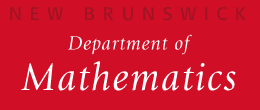What is Math 138 -- Calculus II for Biological Sciences
In the course catalog, this course (640:138) is called Calculus II for the Biological Sciences and is listed as covering: Transcendental Functions, techniques of integration, elementary differential equations and their applications to Biological Sciences, and an introduction to Linear Algebra. Only the first two of these topics are common to the other Calculus II courses (640:136 and 640:152).So what is this course?
The first third of Math 138 is an abridged version of the first half of Calculus 136, skimping on techniques of integration. The second third covers linear differential equations. The Exponential Growth model of explosive population growth comes early. After Spring Break, the Logistic Population Growth Model is covered. This also uses a differential equation to model limits to growth. The final third of the course builds to a different kind of model: the Leslie Model, in which population is modeled by something called a Markov Process.
Historically, Math 138 was created in 1974 as a spin-off from the Unified Calculus sequence 135-136, which still exists. The purpose was to emphasize those parts of Calculus relevant to Biology. Since the late 1980's it has been organized around three models for population growth. The sequence 135-136/138 was re-designed again in 1997, emphasizing the early introduction (in 135) of transcendental functions and the use of Graphing Calculators. In 2004, a new textbook was chosen, and supplements put on line. We have come a long way.
Currently, in Spring 2006, textbook for this course is a Calculus and Its Applications, a custom text, for Rutgers University, published by Pearson Custom Publishing. The text is based primarily on Calculus, Third Edition, by Strauss, Bradley and Smith, but also contains material from Calculus & Its Applications, by Goldstein, both published by Prentice Hall.
The course also requires two supplements to the textbook:
- A two-part supplement, developed at Rutgers, on A. Population Growth Models and B. Linear Algebra.
- A UMAP module Population Projection, by Edward L. Keller.







